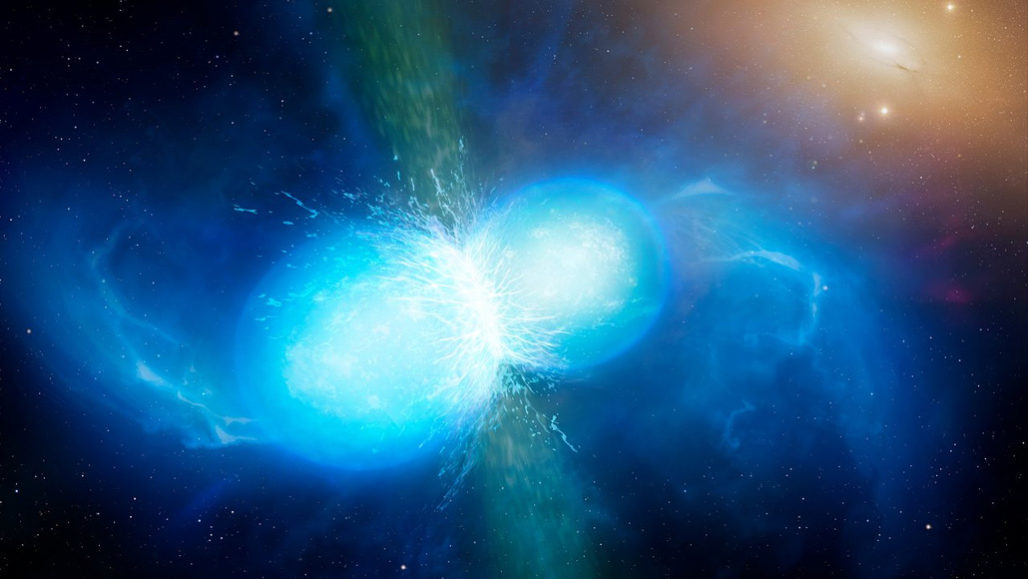First heavy element identified from a neutron-star collision
Seeing this strontium supports the idea that these smashups create many elements heavier than iron

Finding strontium in the afterglow of a neutron star collision (illustrated) provides the most direct evidence yet that such smashups set off an exotic chain of nuclear reactions that can lead to heavy-element formation.
UNIVERSITY OF WARWICK, MARK GARLICK, ESO
Astronomers have for the first time definitively ID’d the birth of a specific heavy element during a neutron-star smashup. They found strontium. And it showed up in the wavelengths of light — or spectra — making up this collision’s afterglow.
Neutron “star” is a bit of a misnomer. These objects actually are the ultra-dense leftovers of large stars that attained old age, exploded and then collapsed back on themselves. Astrophysicist Darach Watson works in Denmark at the University of Copenhagen. His team reported the strontium discovery online October 23 in Nature.
Scientists had assumed that a collision by two super-dense objects, such as neutron stars, would trigger a chain of nuclear reactions. They’re known as the r-process. In such an environment, the nuclei of atoms could rapidly gobble up neutrons. Afterward, those nuclei would become transformed in a process known as radioactive decay. The r-process was seen as a way to transform old, smaller elements into newer, bigger ones. About half of all elements heavier than iron were thought to be made in the r-process.
Finding strontium in the recent collision at last offered the most direct evidence yet that neutron-star collisions really do trigger the r-process.
‘R’ you seeing it?
Physicists had long predicted that silver, gold and many other elements more massive than iron formed this way. But scientists weren’t sure where those r-process reactions took place. After all, no one had directly seen the r-process underway in a celestial event. Or they didn’t until the merger of two neutron stars in 2017. Scientists quickly analyzed light given off by that cataclysm. In it, they found evidence of the birth of a hodgepodge of heavy elements. All would seem to have come from the r-process.
Helen Thompson/Science News/YouTube
But those analyses couldn’t pinpoint precisely which elements were in that mix. Why? The researchers were examining mostly very heavy elements — ones whose complex atomic structures can generate millions of spectral features. And all of those features were not yet fully known, Watson points out. This made it extremely difficult to tease apart which elements were present, he says.
Strontium, however, is relatively light compared to other r-process elements. And its simple atomic structure creates a few strong and well-known spectral clues. So Watson and his colleagues expanded their analysis to consider it. In doing so, they turned up the clear “fingerprint” of strontium. It emerged in light collected by the Very Large Telescope in Chile within a few days of the neutron-star collision.
Seeing strontium in the afterglow wasn’t all that unexpected, says Brian Metzger. He’s an astrophysicist at Columbia University in New York City and not involved in the new work. Strontium, he notes, “does tell us something interesting” about the elements formed during the neutron-star collision.
For instance, the material that produced the strontium must have had an unusually low neutron density (at least compared to what is typically seen inside a neutron star). Otherwise, such an extremely neutron-rich environment as that collision should have created much heavier r-process elements.
The strontium-making neutron-star material probably underwent some other interaction. Maybe it was bombarded by ghostly subatomic particles called neutrinos. They could have been spawned in the collision, Metzger says. “It wasn’t just [normal] neutron star guts” that provided the raw material for this strontium, he concludes.







